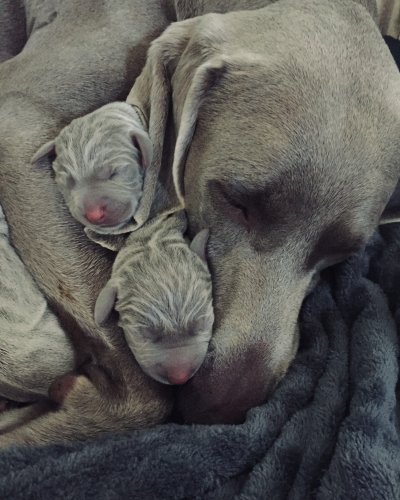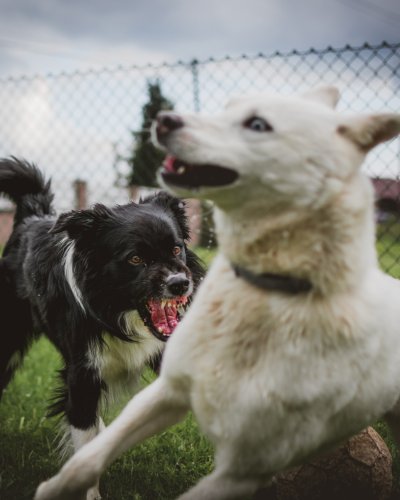Effects of running water on thermal imaging
Temperature regulation in animals is essential to their quality of life. Heat loss from their bodies can occur in multiple ways. This article briefly looks at heat loss from the animal’s body under running water and the use of thermal imaging.
Heat is transferred by different mechanisms; radiation, conduction, convection and phase change (ex: liquids turning into gas). Thermal imaging measures the radiant heat emitted from a body (solid or liquid). The amount of thermal radiation emitted by a body is affected by water, but why is that so, and what are the effects?
A few things happen when cold water is applied to an animal's skin or fur. To understand the occurring processes, we must understand a little about heat. Heat is a form of energy that flows from hot objects to cooler ones; how easily it flows depends on a few factors.
Conduction:
Conduction is the transfer of heat within and between objects; it occurs in solids and static fluids. When applying cold water to an animal's body, there are four points of heat conduction: heat from the animal’s body to the water, through the water, from the water to the surrounding air, and through the air.
Thermal energy is conducted more efficiently through water than air. So, conductive cooling will occur more readily through the water; this is because:
1. Air is a conductive insulator; it resists thermal conduction and has a lower thermal conductive factor than water.
2. Water also has a larger specific heat capacity than air. This means water requires more energy in order to increase its temperature.
The temperature of the water in contact with the animal's body will move towards an equalised state, becoming the same as the animal's body, through the absorption of conductive heat energy.
Once the skin/fur and static water temperatures are equalised, conductive heat transfer will depend on the surrounding air temperature. If the air is hotter than the animal, heat will want to flow into the animal; conversely, if the air temperature is cold, heat will flow out of the body.
Convection:
Convection is the transfer of heat through or due to the movement of fluids such as air and water. This movement can be caused by external forces such as gravity pulling the water down to the ground or through natural convection caused by fluid density change caused by an increase in temperature. Heat creates movement in fluids; hotter fluids move away from the heat source, providing a natural cooling mechanism as the heat dissipates into the surrounding environment.
Since heat moves from hot to cold, a problem occurs when the environmental air temperature equals or exceeds the animal's body temperature. In this case, convective heat loss is prevented.
Radiation:
Heat radiation is a form of energy that travels in the infrared light spectrum via waves. Radiation is both emitted and absorbed by animals.
The amount of radiation absorbed by their bodies depends on several factors, including:
1. Their colour
2. The reflective nature of their surface (skin/fur)
3. How much thermal radiation they are exposed to (direct sunlight/shade shelter)
4. The angle of wave penetration
The amount of radiation given off by their body is also dependent on several factors, such as:
1. What the surface material is (thickness/constitution/absence of hair, condition of skin)
2. The underlying physiological process (vascular/metabolic/etc.)
Measuring the radiant heat can be done with thermal imaging cameras. However, it will only provide an accurate picture of the surface temperature if the radiation is unimpeded. Emissivity and the angle of the body to the camera can also affect the thermal imaging readings.
Look at my video showing what happens when I put my hand behind running water and then immerse it in the water.
Evaporative cooling:
Evaporative cooling occurs when there is a phase change; liquid water on the surface of the animal heats up and turns into water vapour or steam. This gaseous water has more energy than the liquid water even though it can be at the same temperature.
Energy is absorbed from the animal's body to facilitate this phase change; the energy is then dissipated into the environment through natural convection. Resulting in a net loss of heat from the body. Seeing steam is a good indication that evaporative cooling is taking place and heat is removed from the body.
When humidity is high, it will be harder for this phase change to occur as the air is already saturated with water. So, the performance of evaporative cooling is reduced.
Cooling with running water:
A few things happen when cool water runs over an animal's body. Firstly, the method of heat transfer changes from primarily natural convection and radiation to forced convection and conduction. The moving water in contact with the body rapidly absorbs heat energy as it falls across the body. This creates a cooling effect.
Radiant heat loss is reduced due to the water preventing heat radiation from escaping, and thermal imaging reflects this.
Conclusion:
So, what does this tell us? The heat loss mechanisms are different in the three states: dry, running water, and static water. Environmental conditions also play a role in heat transfer. Although cool running water will provide an efficient cooling solution, thermal imaging cannot accurately detect the surface temperature of the animal's body under running water because the flowing water inhibits radiant heat flow.





Leave a comment